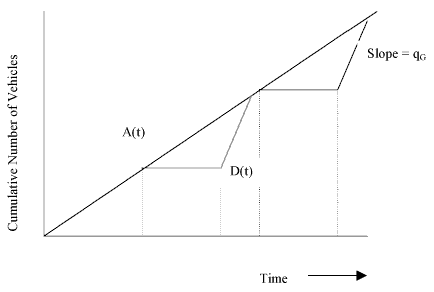


|

Queuing Theory
Greenshield’s model was developed to aid our understanding of uninterrupted flow.
Unfortunately, Greenshield’s model is unable to cope with the added complexities that
are generated under interrupted flow conditions. Interrupted flow requires an
understanding of Queuing Theory, which is an entirely separate model of traffic flow.
Queuing Theory can be used to analyze the flow of traffic on the approach to and
through an intersection controlled by a traffic signal. This is accomplished by analyzing
the cumulative passage of vehicles as a function of time. The queuing diagram for
interrupted flow shows the flow on one intersection approach. Traffic is stopped from time
t1 to t2 during the red signal interval. At the start of the green
interval (t2), traffic begins to leave the intersection at the saturation flow
rate (qG), and continues until the queue is exhausted. Thereafter, the
departure rate D(t), equals the arrival rate, A(t), until t3, which is the
beginning of the next red signal. At this point, the process starts over.
For further information on Queing Theory, consult the chapter entitled "Signal
Timing Design."

Queuing Diagram for Interrupted Flow
1.) Papacostas , C.S. and Prevedouros, P.D., Transportation Engineering and
Planning, 2 nd Edition, Prentice Hall, Englewood Cliffs, New Jersey, 1993
|